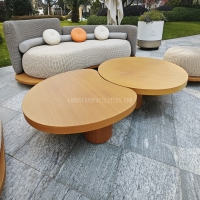Welcome to the website for landscape facilities products and knowledge.
What are the most common issues related to drainage in landscape bar counters with integrated sinks, and how can they be resolved?
Landscape bar counters with integrated sinks have become increasingly popular in modern homes, offering a seamless and stylish look for entertainment areas. However, this sophisticated design can present unique drainage challenges that homeowners should be aware of. Understanding these common issues and their solutions can help maintain both the functionality and aesthetic appeal of your bar area.
The most frequent drainage problem in these installations is clogging. Unlike traditional sinks, integrated sinks often have narrower drain pipes that can easily accumulate debris from glass rinsing, fruit remnants, or small food particles. This buildup gradually restricts water flow until complete blockage occurs. To resolve this, begin with a simple boiling water flush to break down grease-based obstructions. For more stubborn clogs, use a mixture of baking soda and vinegar followed by hot water. Avoid chemical drain cleaners as they can damage the sink's finish and plumbing components.
Another prevalent issue is slow drainage, which typically results from improper installation rather than blockages. Many landscape bar counters feature extended drain lines that travel horizontally before connecting to main vertical pipes. If these horizontal sections lack adequate slope (minimum 1/4 inch per foot), water will not drain efficiently. correcting this requires checking the pipe alignment and adjusting the slope, which may involve partial disassembly of the cabinetry beneath the counter.
Improper sealing around the sink integration point represents another common concern. Since integrated sinks are seamlessly joined to the countertop material (typically quartz, granite, or concrete), any gap in the sealing can allow water to seep into the cabinetry below. This moisture intrusion can cause wood warping, mold growth, and structural damage over time. Inspect the perimeter seal regularly and reapply a high-quality silicone sealant at the first sign of deterioration.
Many homeowners also encounter problems with inadequate venting in bar sink drainage systems. Proper venting prevents air locks that impede water flow and cause gurgling sounds during drainage. If your bar sink drains slowly and makes unusual noises, the plumbing may need an air admittance valve or additional venting installed by a professional plumber.
For bar sinks equipped with garbage disposals, additional challenges may arise. The vibration from disposal units can loosen pipe connections over time, leading to leaks beneath the sink. Regularly inspect the connections and use plumber's putty or thread seal tape to secure any loose fittings. Additionally, avoid putting fibrous or starchy materials through bar sink disposals to prevent jams.
Preventative maintenance remains the best approach to avoiding drainage problems in landscape bar counters. Install sink strainers to catch debris before it enters the drainage system, and periodically flush the pipes with hot water to prevent grease accumulation. For persistent issues, consult a professional plumber experienced with integrated sink systems to ensure proper diagnosis and repair without compromising the counter's aesthetic integrity.
By addressing these common drainage issues proactively, homeowners can maintain both the functionality and elegant appearance of their landscape bar counters with integrated sinks, ensuring these stylish fixtures remain practical for everyday use and entertaining.
Related search:

Recommendation
Elliptical metal outdoor table with nested design, resembling wood grain, round table